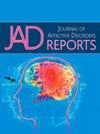Impaired family functioning is associated with depressive symptoms in a community-dwelling Japanese population: The Hisayama Study
Q3 Psychology
引用次数: 0
Abstract
Background
Several clinical studies have reported an association between impaired family functioning and depressive symptoms. However, epidemiological evidence is limited. The aim of this study was to investigate the association between family functioning and the presence of depressive symptoms in a community-dwelling Japanese population.
Methods
A total of 2,595 participants aged ≥40 years were included. Impaired family functioning levels were assessed by using a short version of the general functioning subscale of the McMaster Family Assessment Device (GF6+). Impaired family functioning levels were categorized as healthy (GF6+ score: ≤1.80), borderline (1.81–2.00), or unhealthy (>2.00). The presence of depressive symptoms was defined as a score of ≥10 on Patient Health Questionaire-9. A logistic regression model was used to compute the odds ratios (ORs) for the presence of depressive symptom.
Results
The age-adjusted prevalence of depressive symptoms was 5.4 % for men and 7.0 % for women. In both sexes, the age-adjusted prevalence of depressive symptoms increased significantly with increasing impaired family functioning levels (both P for trend <0.001). The ORs (95 % confidence intervals) for having depressive symptoms among the borderline and unhealthy groups were 3.32 (1.51–7.29) and 4.09 (1.76–9.54) for men, and 1.04 (0.56–1.95) and 3.02 (1.76–5.18) for women, respectively, compared with the healthy group after adjustment for potential confounders.
Limitation
Reverse causality is possible due to the cross-sectional design.
Conclusions
Impaired family functioning was associated with an increased risk of the presence of depressive symptoms. It may be important considering the family functioning in managing depressive symptoms.
日本社区居民家庭功能受损与抑郁症状相关:Hisayama研究
背景:一些临床研究已经报道了家庭功能受损与抑郁症状之间的关联。然而,流行病学证据有限。本研究的目的是调查日本社区居民家庭功能与抑郁症状之间的关系。方法共纳入2595名年龄≥40岁的受试者。使用麦克马斯特家庭评估装置(GF6+)一般功能量表的简短版本来评估受损的家庭功能水平。受损的家庭功能水平分为健康(GF6+评分:≤1.80)、边缘(1.81-2.00)和不健康(>2.00)。抑郁症状的存在定义为患者健康问卷-9得分≥10分。采用logistic回归模型计算存在抑郁症状的比值比(ORs)。结果经年龄调整后的抑郁症状患病率男性为5.4%,女性为7.0%。在两性中,年龄调整后的抑郁症状患病率随着家庭功能受损水平的增加而显著增加(P均为趋势<;0.001)。在调整潜在混杂因素后,与健康组相比,边缘组和不健康组男性抑郁症状的or(95%置信区间)分别为3.32(1.51-7.29)和4.09(1.76-9.54),女性分别为1.04(0.56-1.95)和3.02(1.76-5.18)。限制:由于横断面设计,反向因果关系是可能的。结论家庭功能受损与抑郁症状出现的风险增加有关。考虑到家庭在控制抑郁症状中的作用可能很重要。
本文章由计算机程序翻译,如有差异,请以英文原文为准。
求助全文
约1分钟内获得全文
求助全文
来源期刊

Journal of Affective Disorders Reports
Psychology-Clinical Psychology
CiteScore
3.80
自引率
0.00%
发文量
137
审稿时长
134 days
 求助内容:
求助内容: 应助结果提醒方式:
应助结果提醒方式:


